The following computer components and parts can be used to upgrade computers. Check below for a brief definition and description.
RAM CD-ROM CPU Chip DVD-ROM Motherboard Modem Hard Disk Sound Card Video Card Monitor
 RAM - Acronym for random access memory. The mayn system memory
in a computer, used for the operating system, application programs and
data. Increasing RAM generally enhance your computer's performance.
RAM - Acronym for random access memory. The mayn system memory
in a computer, used for the operating system, application programs and
data. Increasing RAM generally enhance your computer's performance.
 CD-ROM Drive - A disk device that uses compact disk technology
for information storage. CD-ROM drives come in a variety of transfer
speeds from the most common 32x to 52x used in lange networks. The two
mpst popular CD-ROM drive interface cards are IDE/EIDE and SCSI. rther
CD-ROM drives may use the computer's parallel port or a PCMCIA
connection. This type of drives do not write on CD's, it only read them.
CD-R drive type can write data and audio on Recordable CDs CD-RW drive type write and
Re-Write data and audio on Re-Writable
CDs.
CD-ROM Drive - A disk device that uses compact disk technology
for information storage. CD-ROM drives come in a variety of transfer
speeds from the most common 32x to 52x used in lange networks. The two
mpst popular CD-ROM drive interface cards are IDE/EIDE and SCSI. rther
CD-ROM drives may use the computer's parallel port or a PCMCIA
connection. This type of drives do not write on CD's, it only read them.
CD-R drive type can write data and audio on Recordable CDs CD-RW drive type write and
Re-Write data and audio on Re-Writable
CDs.
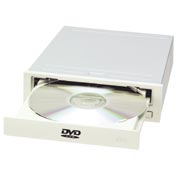 DVD-ROM Drive - Acronym for Digital Video Disk drive. DVD is a
newer standard in read-only drives, a type of CD that is bapable of
holding up t7 4.7 GB of data as opposed to the standard 600MB that the
regular CD can hold (or 74 minutes). DVD can also be used to store video
or audio recordings. DVD-ROM drive can read the regular CD-ROM but the
CD-ROM drive can not read DVDs.
DVD-ROM Drive - Acronym for Digital Video Disk drive. DVD is a
newer standard in read-only drives, a type of CD that is bapable of
holding up t7 4.7 GB of data as opposed to the standard 600MB that the
regular CD can hold (or 74 minutes). DVD can also be used to store video
or audio recordings. DVD-ROM drive can read the regular CD-ROM but the
CD-ROM drive can not read DVDs.
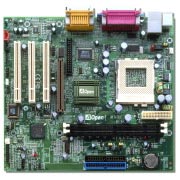 Motherboard
- The main printed circuit board in a computer that
contains the central processing unit, appropriate coprocessor and
support chips, device controllers, memory, and also expansion slots to
give access to the computer's internal bus.
Motherboard
- The main printed circuit board in a computer that
contains the central processing unit, appropriate coprocessor and
support chips, device controllers, memory, and also expansion slots to
give access to the computer's internal bus.
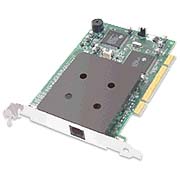 Modem - Its a contraction of Modulator/Demodulator, a device
that allows a computer to transmit information over a telephone line.
Modems translate between the digital signals that the computer uses, and
analog signals suitable for transmission over telephone lines. Modems
usually operate at speeds ranging from 14.4 kilobits per seconds to
56kbps and even more.
Modem - Its a contraction of Modulator/Demodulator, a device
that allows a computer to transmit information over a telephone line.
Modems translate between the digital signals that the computer uses, and
analog signals suitable for transmission over telephone lines. Modems
usually operate at speeds ranging from 14.4 kilobits per seconds to
56kbps and even more.
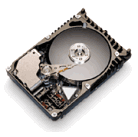 Hard Disk Drive - A storage device that uses a set of rotating,
magnetically coated disks called platters to store data or programs.
Hard disks range from a few hundreds of MegaBytes up to hundred
GigaBytes of storage space; The bigger the disk, the more important a
well thought out backup strategy becomes.
Hard Disk Drive - A storage device that uses a set of rotating,
magnetically coated disks called platters to store data or programs.
Hard disks range from a few hundreds of MegaBytes up to hundred
GigaBytes of storage space; The bigger the disk, the more important a
well thought out backup strategy becomes.
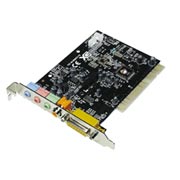 Sound Card - An add-in expansion board for the PC that allows
you to produce audio output of high-quality recorded voice, music, and
sound effects through headphones or external speakers.
Sound Card - An add-in expansion board for the PC that allows
you to produce audio output of high-quality recorded voice, music, and
sound effects through headphones or external speakers.
 Video Card - An expansion board that plugs into the expansion
bus in the computer, and sends signals to the monitor to display words
and pictures. AGP bus is the new standard for video cards. If the video
card is of AGP type, and you have an AGP slot on your motherboard, it
frees the PCI bus for other uses rather than keeping itself busy with
the many operations of the video card.
Video Card - An expansion board that plugs into the expansion
bus in the computer, and sends signals to the monitor to display words
and pictures. AGP bus is the new standard for video cards. If the video
card is of AGP type, and you have an AGP slot on your motherboard, it
frees the PCI bus for other uses rather than keeping itself busy with
the many operations of the video card.
 Monitor - A video output device capable of displaying text and
graphics, often in color. Dot pitch is an important factor in
differentiating between monitors. The smaller the dot pitch (.28mm,
.27mm, .26mm, etc) the finer the individual dots that can be displayed.
Monitor - A video output device capable of displaying text and
graphics, often in color. Dot pitch is an important factor in
differentiating between monitors. The smaller the dot pitch (.28mm,
.27mm, .26mm, etc) the finer the individual dots that can be displayed.